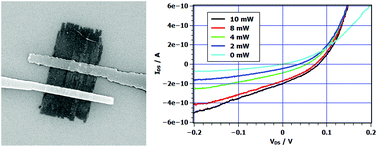Photovoltaic effect in individual asymmetrically contacted lead sulfide nanosheets†
Abstract
Solution-processable, two-dimensional semiconductors are promising optoelectronic materials which could find application in low-cost solar cells. Lead sulfide nanocrystals raised attention since the effective band gap can be adapted over a wide range by electronic confinement and observed multi-exciton generation promises higher efficiencies. We report on the influence of the contact metal work function on the properties of transistors based on individual two-dimensional lead sulfide nanosheets. Using palladium we observed mobilities of up to 31 cm2 V−1 s−1. Furthermore, we demonstrate that asymmetrically contacted nanosheets show photovoltaic effect and that the nanosheets’ height has a decisive impact on the device performance. Nanosheets with a thickness of 5.4 nm contacted with platinum and titanium show a power conversion efficiency of up to 0.94% (EQE 75.70%). The results underline the high hopes put on such materials.


 Please wait while we load your content...
Please wait while we load your content...